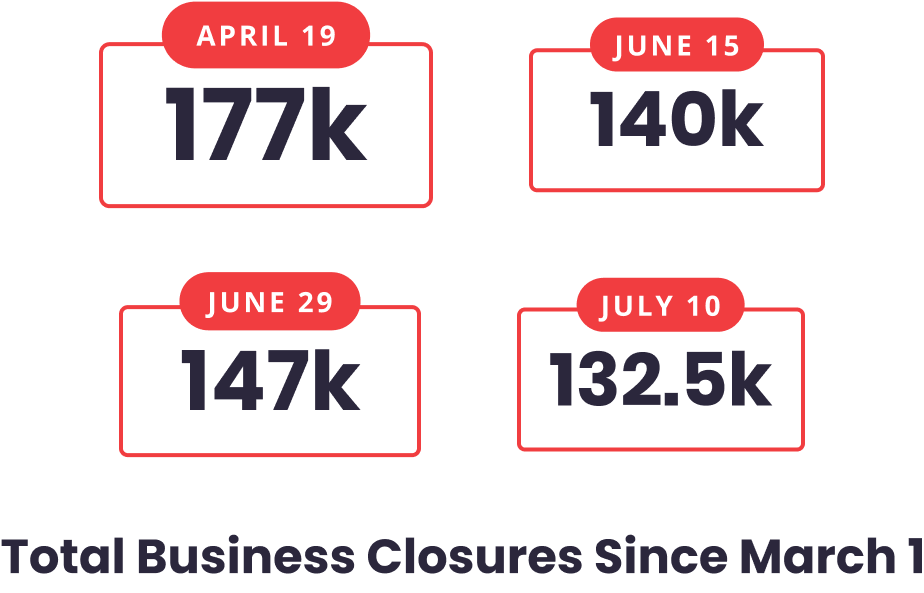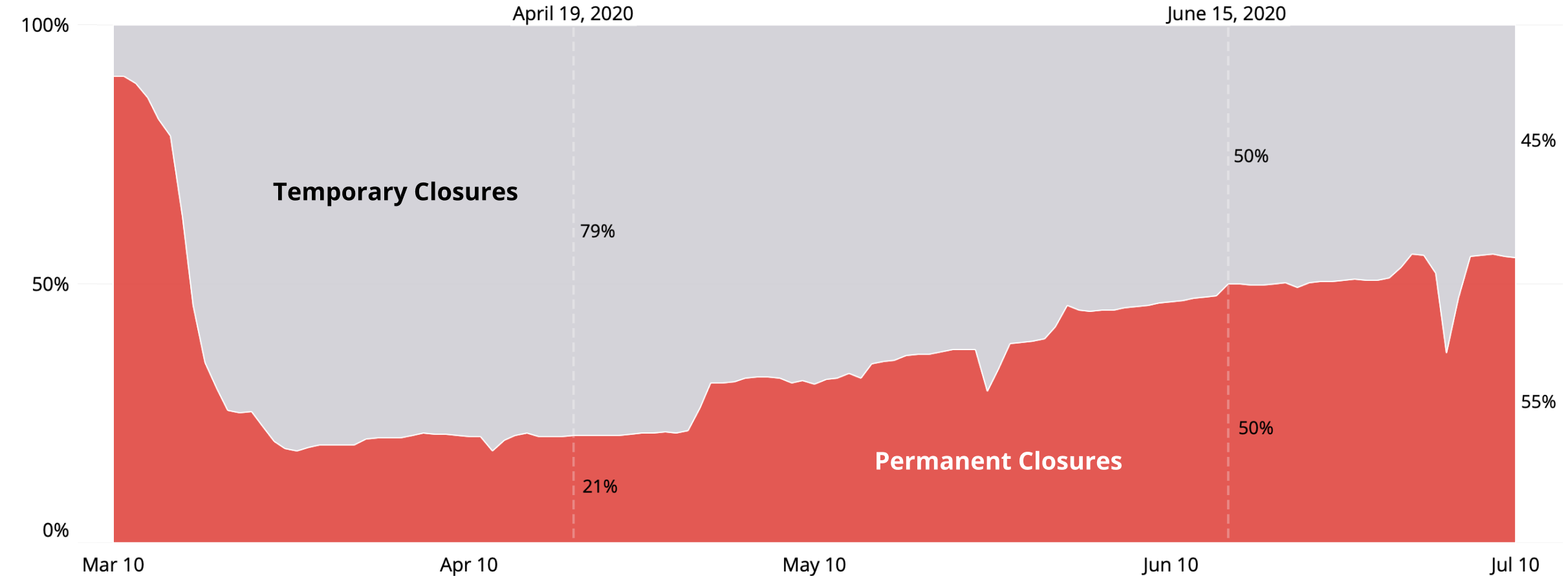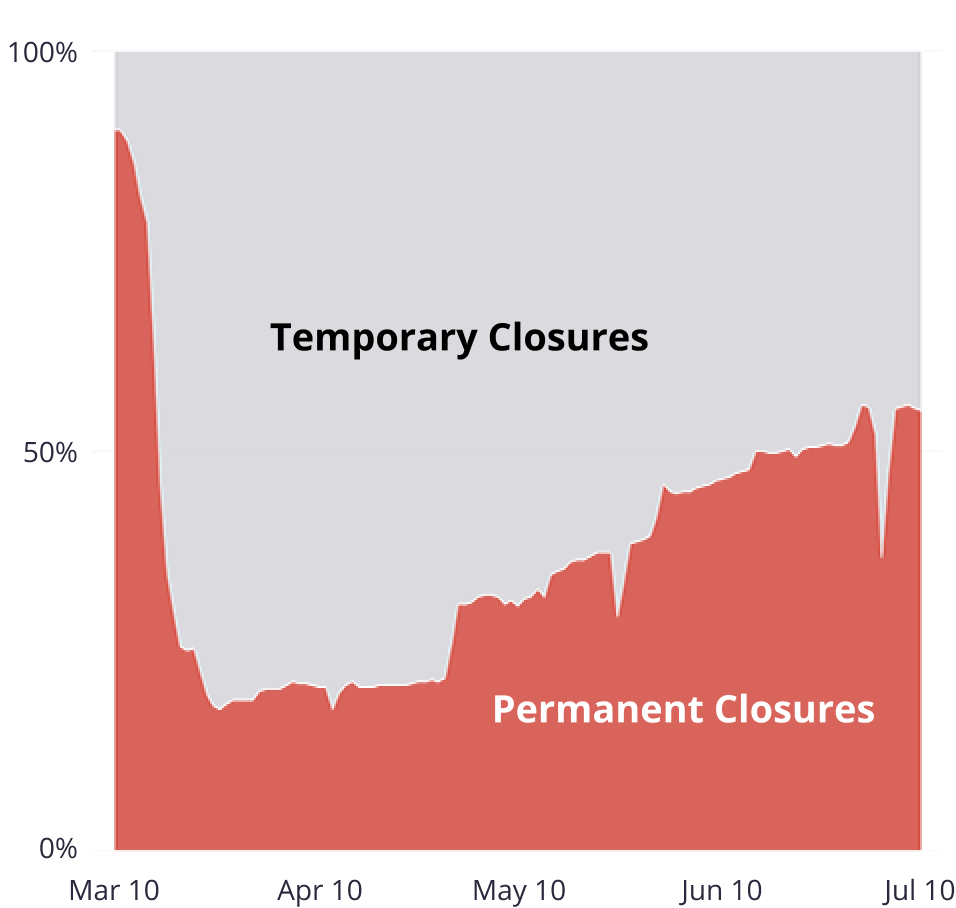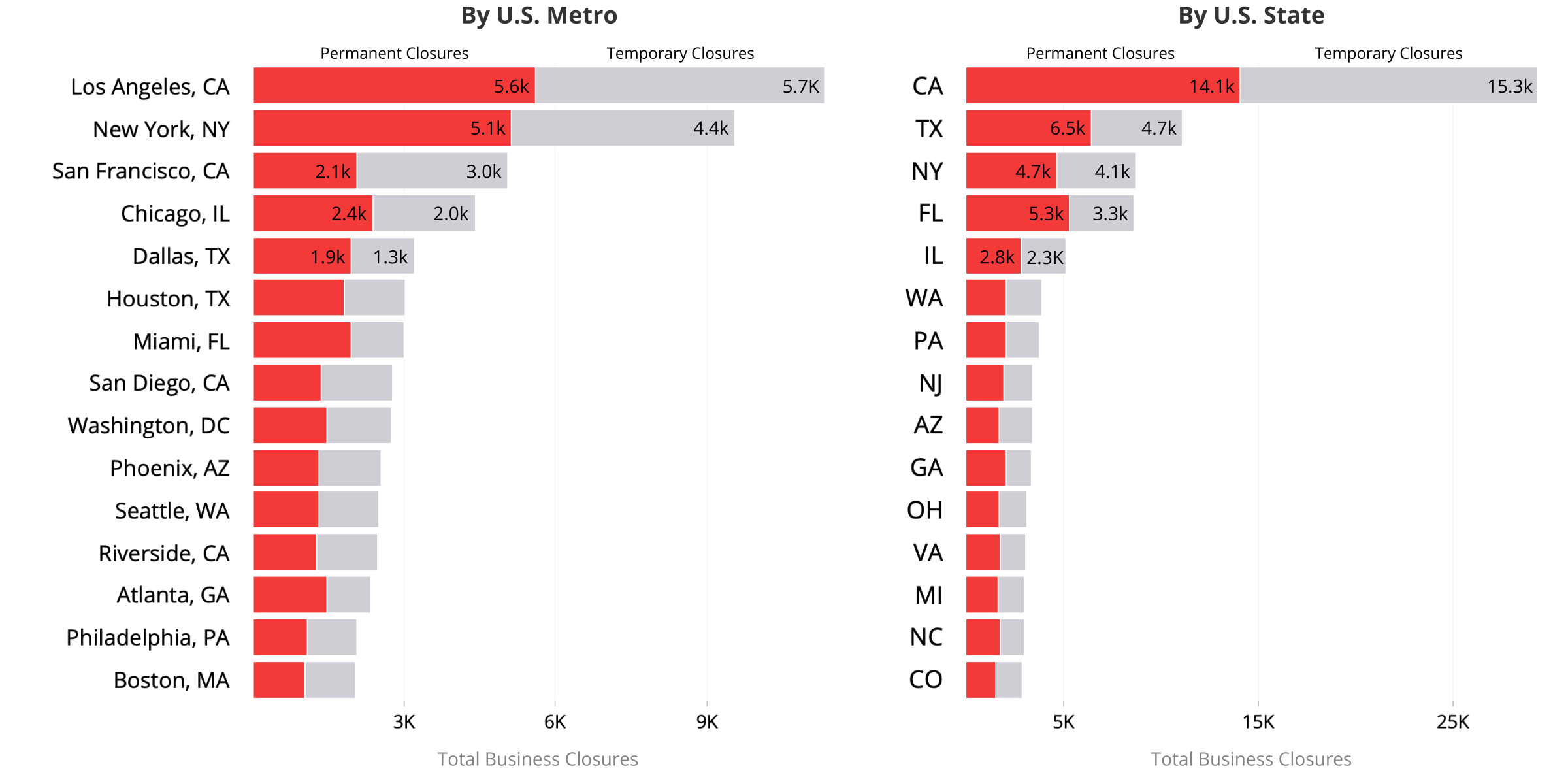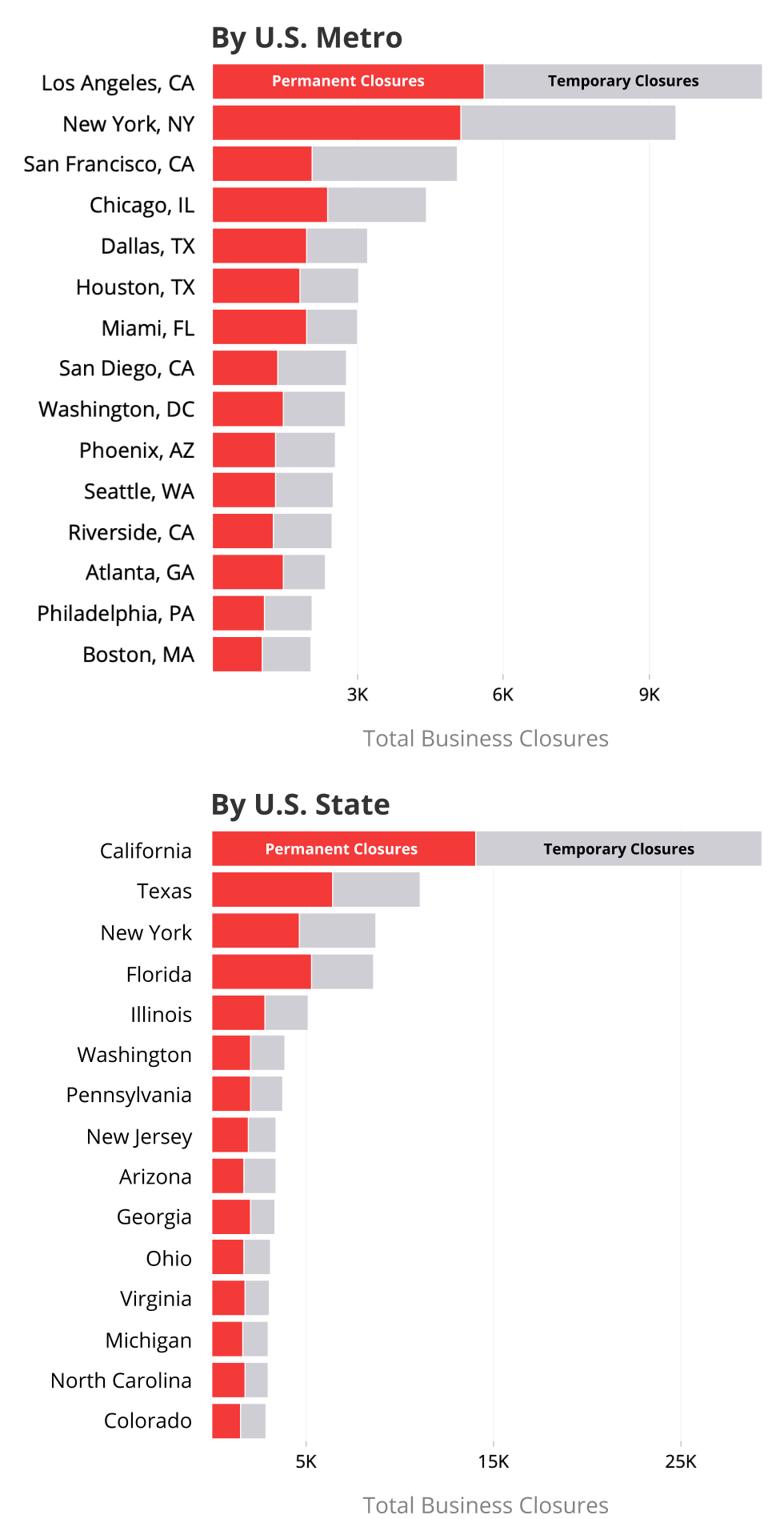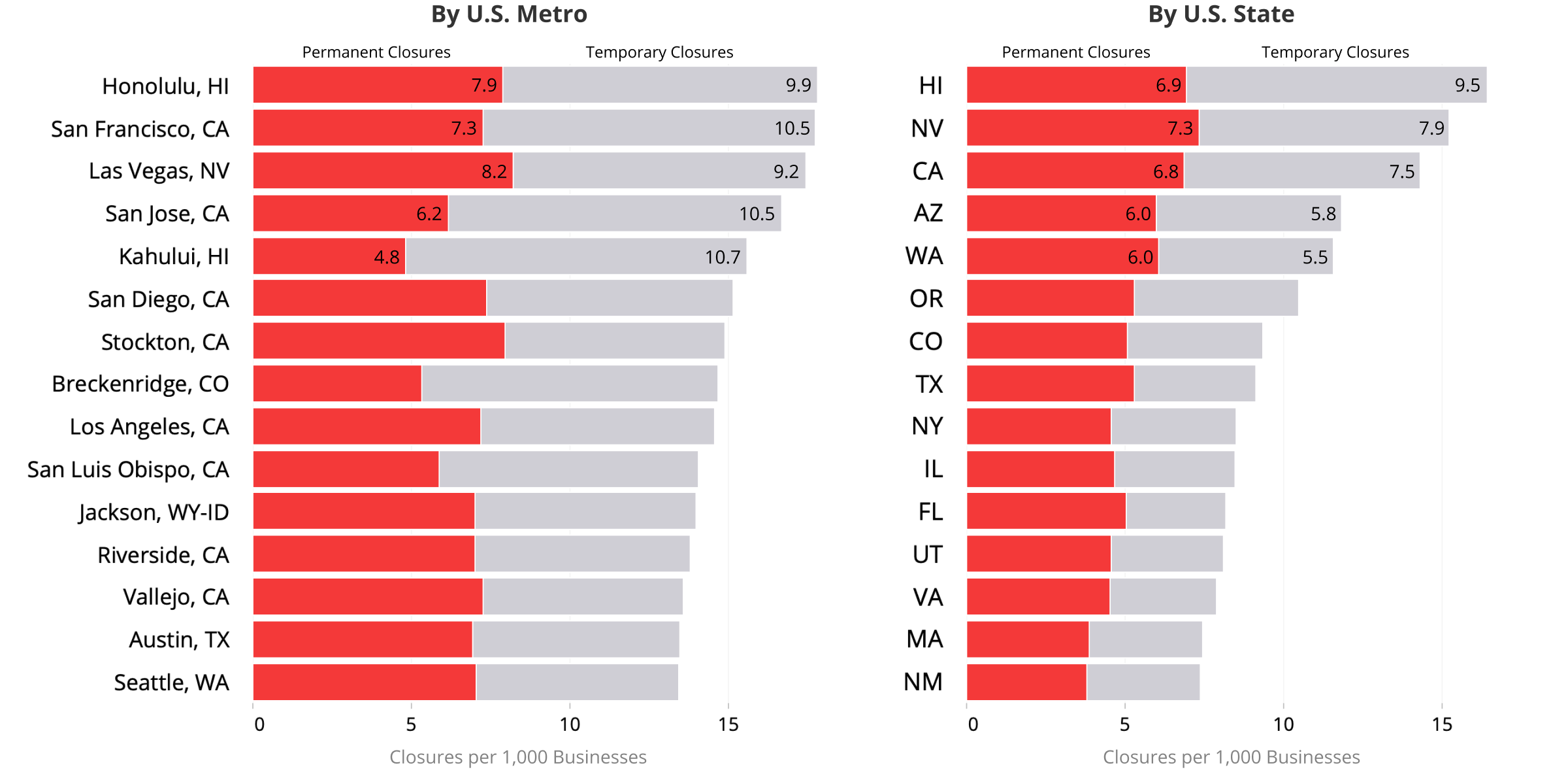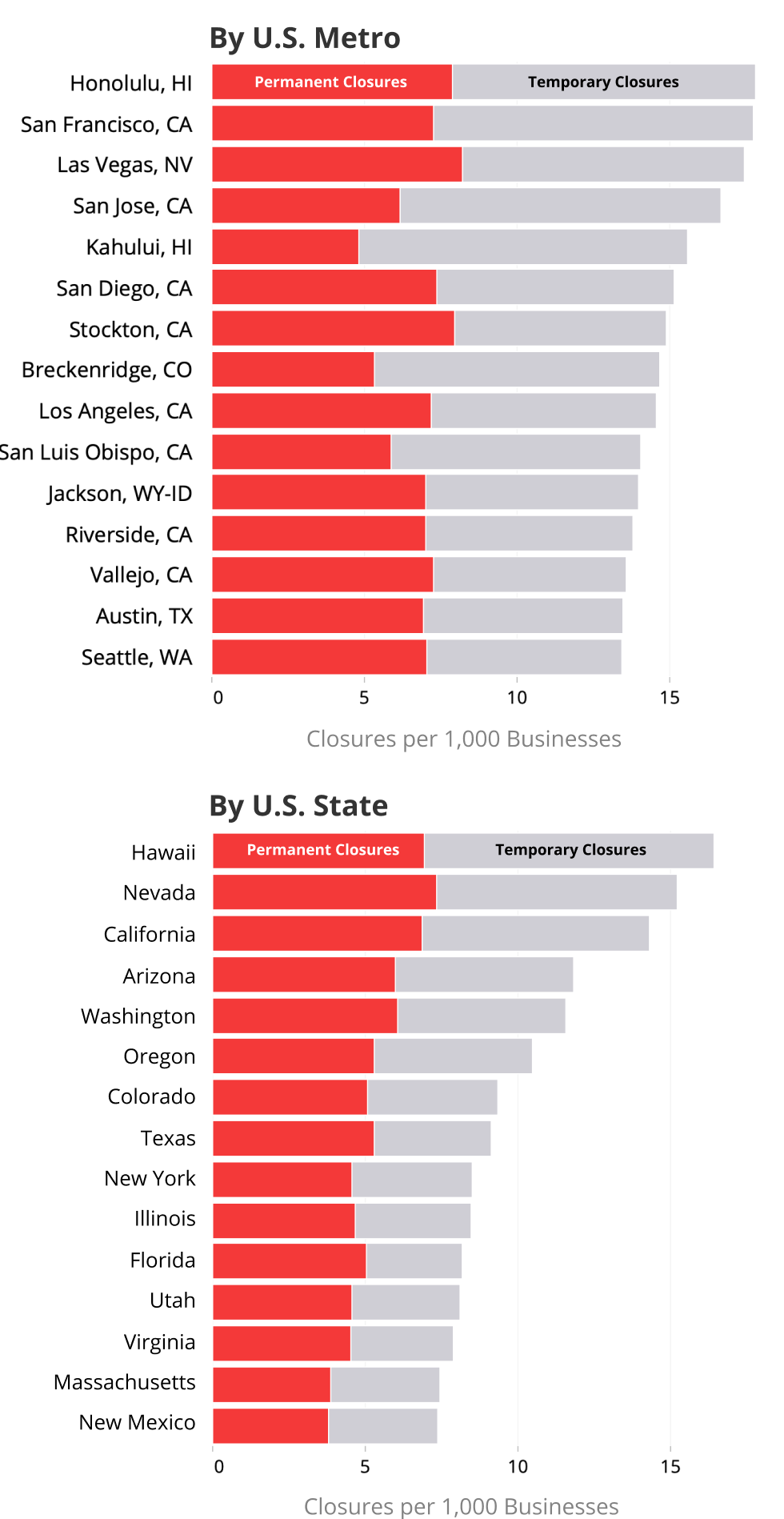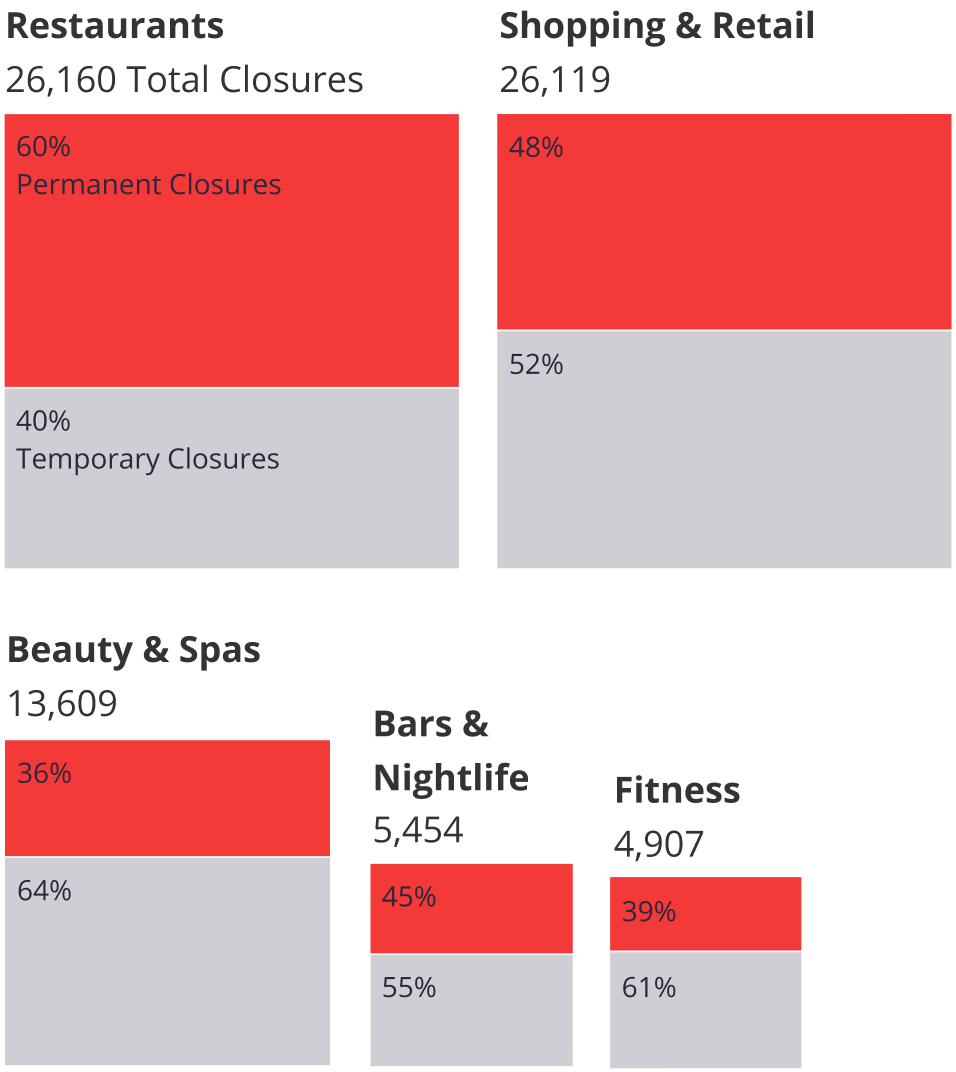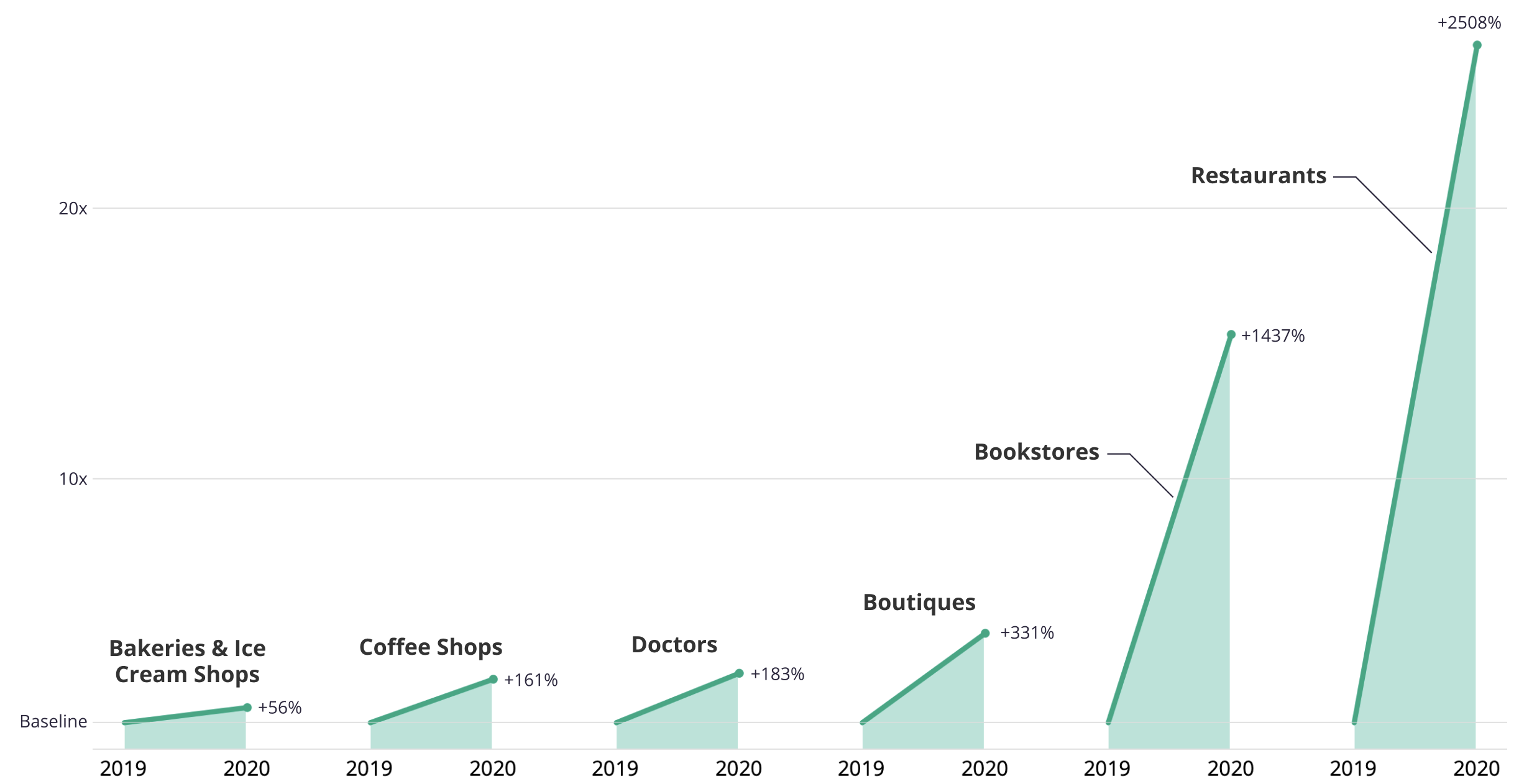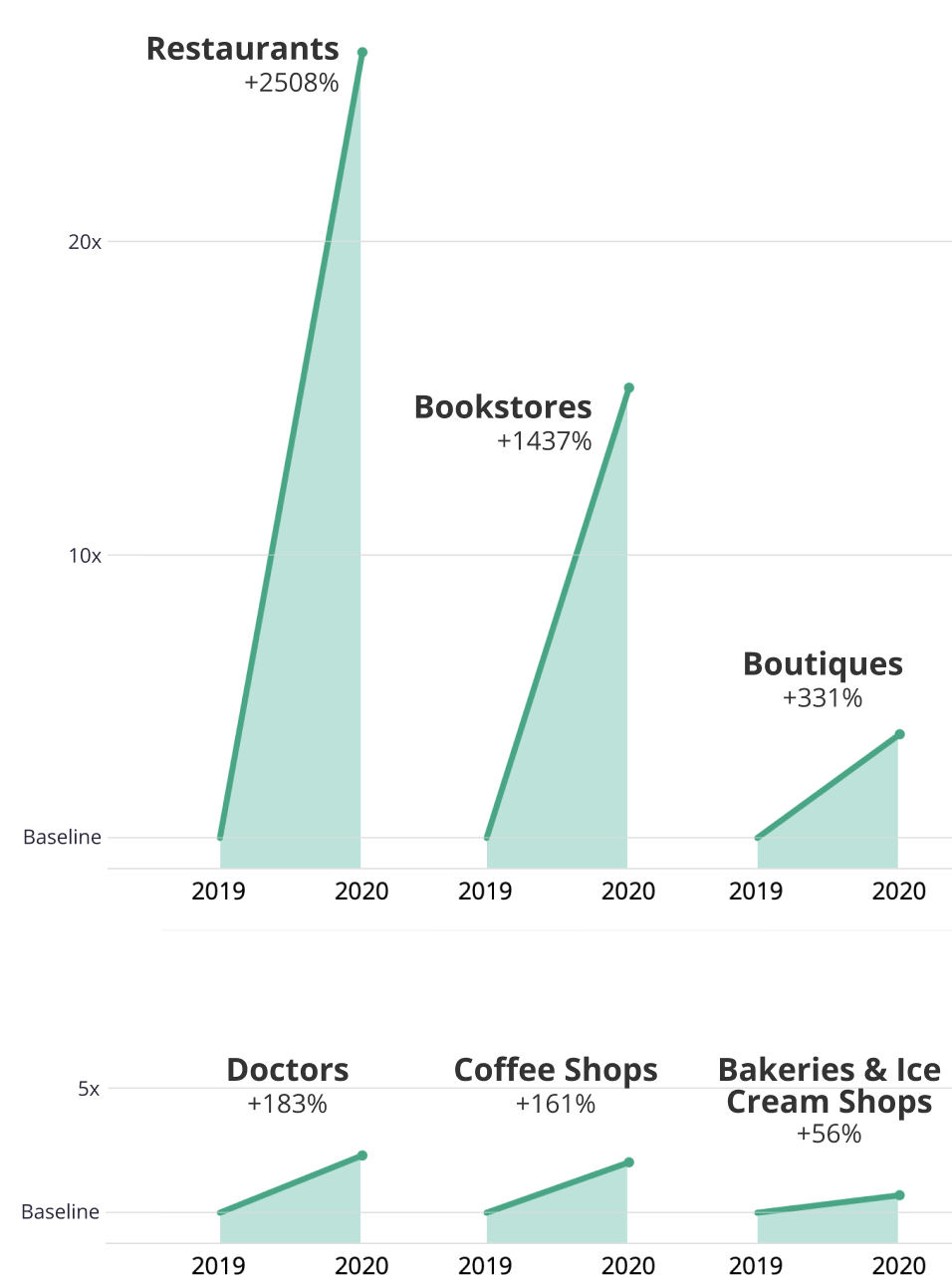Q2 2020
Increased Consumer Interest in May Correlates with COVID-19 Hot Spots in June, According to the Yelp Economic Average
As cities reopen and COVID-19 cases continue to rise across the country, local governments have taken action, pivoting their reopening plans. Many businesses that eagerly reopened doors in June were forced to scale back operations and in some cases even shut down again — a costly action for many small businesses.
Yelp’s latest Local Economic Impact Report, published in June, showed a decrease of business closures compared to April and an increase in consumers getting back to their normal activities – such as dining in at restaurants, heading back into shopping malls and planning weddings. We’re now beginning to uncover longer term trends including a correlation between interest in restaurants, bars and nightlife, and gyms to a spike in COVID-19 cases across hotspot states. The report also measures business closure data that reflects an unstable economy; slower, but still consistent changes in consumers getting back to pre-pandemic activities; and sustained interest in supporting Black-owned businesses.
Increased Consumer Activity in May Correlates with Increased COVID-19 Cases in June
In mid-to-late March we saw consumer activity drop swiftly and uniformly across the nation. This new status quo was maintained in most states through at least mid-to-late April. In May, some states maintained the shutdown level of consumer interest, but many started to revert towards the pre-pandemic norm.
As outbreaks worsened through late June, consumer interest in these categories started to come back down in states like Florida, Texas, South Carolina, and Arizona. This emphasizes the strong correlation between the pandemic and consumer behavior. When there's a major outbreak, Yelp data suggests it negatively impacts consumer interest in businesses where social distancing may be harder to enforce. If COVID-19 cases remain flat or decrease in a state, consumer behavior and local policies tend to revert towards the pre-pandemic norm, leaving the state vulnerable to a major outbreak in the near future. These outbreaks may then require stricter measures to suppress cases, as we are currently seeing in California and Florida.
Business Closures Fluctuate Across the Nation
The curve in business closures that we once saw going down has continued to change over the last month. We last reported 140,000 total businesses closures on Yelp from March 1 to June 15. We saw this increase to more than 147,000 total business closures on June 29 and then drop again to just more than 132,500 total business closures as of July 10. This rapidly changing number of closures reflects rapidly evolving situations at the local level, as some states with rising cases start to close again, while others continue to reopen. In April, we reported more than 175,000 business closures indicating that only 24% of businesses that were closed in April have reopened.
Even as total closures fall, permanent closures increase with 72,842 businesses permanently closed, out of the 132,580 total closed businesses, an increase of 15,742 permanent closures since June 15. This also means that the percentage of permanent to temporary business closures is rising, with permanent closures now accounting for 55% of all closed businesses since March 1, an increase of 14% from June when we reported 41% of closures as permanent. Overall, permanent closures have steadily increased since the peak of the pandemic with minor spikes in March, followed by May and June.
The Share of Permanently Closed Businesses is Rising
Share of business closures on Yelp that were temporary vs. permanent
Most states have seen a plateau of temporary closures, while Arizona, Texas, and Florida have started to see a recent increase again due to spikes in COVID-19 cases. California, Texas, and New York have the highest total number of closures (29,351, 11,118 and 8,731, total closed businesses, respectively).
On a metro level, Las Vegas, NV, is suffering from the highest rate of permanently closed businesses with 861 businesses permanently closed, as the city reacts to a decrease in tourism. Meanwhile, Los Angeles, CA, has the most closures with 11,342 total temporary and permanent business closures.
Where are the Most Businesses Closed?
Geographic areas with the largest number of business closures since March 1
Permanent Closures Continue to Increase Across Restaurants, Retail and Other Industries
While some industries have been able to slowly bounce back with fewer temporary closures, many are still enduring an increasing number of permanently closed businesses.
The restaurant industry now reflects the highest total business closures, recently surpassing retail. As of July 10, there have been 26,160 total restaurant closures, an increase of 2,179 since June 15. Of the all closed restaurants in July, 15,770 have permanently closed (60%), accounting for 2,956 more permanent closures, a 23% increase since June 15. Meanwhile, bars and nightlife, an industry 6X smaller than restaurants, have endured an especially high closure rate, with 5,454 total business closures, 2,429 (44%) of which are permanent closures.
Many retail businesses shifted their operating models and started offering curbside pickup and online ordering, unfortunately those measures aren’t always enough to sustain their business long term. Shopping and retail businesses have endured 26,119 total business closures, of which 12,454 are permanent, representing 48% of closed retail businesses on Yelp. On June 15, we reported 27,663 closed retail and shopping businesses, of which only 9,640 were permanently closed. Since then we’ve seen 1,544 retail businesses reopen, however an even higher number have been forced to shut their doors permanently, accounting for 2,814 new permanent closures, a 29% increase in permanent retail closures in the last month.
The beauty industry follows a similar trend as the retail industry with 13,609 total business closures, a decrease from 15,348 in June, as many businesses have been able to reopen their brick and mortar locations. However, the industry has suffered from 1,213 new permanent closures since June 15, totalling 4,897 permanent closures as of July 10.
Similar to retail and beauty, though there are fewer temporarily closed businesses, the fitness industry has also suffered from an increase in permanent closures. As of July 10, there have been 4,907 total fitness closures, a decrease of 682 closed businesses since June 15. However, of all closed fitness businesses 1,930 are permanently closed, representing 39% of closed fitness businesses on Yelp – 504 more permanent closures than in June. While some fitness businesses have been able to continue operating through virtual classes, many smaller brick and mortar studios have been forced to shut their doors permanently, as these small businesses battle affording high rent and operating expenses without being able to use their physical space.
Restaurants and Retail Continue to Struggle
Number of businesses marked closed on Yelp that were open March 1
While many businesses are struggling right now, there are a few that have been able to withstand the economic downturn. Professional services such as lawyers (840 closures) and accountants (294 closures) are seeing fewer closures. Online services like web design (402 closures) and graphic design (308 closures) are also doing well during the pandemic as many businesses have shifted to remote work. Health services such as physicians (1,560 closures), counseling and mental health services (342 closures), and health coaches (52 closures) are also closing at lower rates – all critical resources during this time. Education businesses (3,458 total closures) have also had success weathering the storm, including private tutors (122 closures), as people look for resources to learn new skills and parents seek resources to supplement distance learning.
Consumer Interest Steadily Returns to Pre-Pandemic Activities
Consumer interest has continued to shift since May, but less rapidly than we saw in March and April. Interest for alcohol-related experiences has increased since June 1, relative to other food activities, with a rise in consumer interest for wineries (up 51%), cideries (up 39%), breweries (up 24%) and distilleries (up 19%). Meanwhile, grocery related businesses are on the decline as people spend less time at home, including beer, wine and spirit stores (down 21%), community supported agriculture (down 23%), and organic stores (down 11%).
Within restaurants, German cuisine, live and raw food, French cuisine and steakhouses have all seen an increase in consumer interest since June 1, relative to other restaurant categories, up 35%, 36%, 21% and 20%, respectively. As people head back into restaurants, fast casual and common delivery foods continue to decline at a slow rate, including fast food (down 19%), cheesesteaks (down 8%), chicken wings (down 15%) and pizza (down 7%).
As the weather gets warmer people are turning to public markets to do their shopping, as well as flea markets and outlet stores, up 73%, 28% and 13%. Formal wear (up 46%) and bridal shops (up 26%) continue to slowly increase as people feel more comfortable gathering for celebrations. Meanwhile, previous retail categories that gained traction, including hunting and fishing supplies, and outdoor gear, are starting to decline in consumer interest, down 40% and 29%. Yelp data also shows people heading back indoors for activities like axe throwing (up 51%), escape games (up 45%) and boxing (up 13%), while some people continue to flock to outdoor activities, like ziplining (up 44%), ATV rentals (up 37%), and amusement parks (up 6%) as the weather heats up.
We also see the impact of rising COVID-19 cases on health and wellness categories on Yelp, with a recent spike in interest for urgent care (up 42%) and emergency rooms (up 21%), since June 1, while interest declined in skilled nursing (down 22%) and retirement homes (down 14%).
How Business Categories are Faring
Change in share of relative consumer interest on Yelp for select business types
Many industries that suffered during the peak of the pandemic are starting to bounce back. For industries that saw an increase at the peak of the pandemic, some have since declined, while others have sustained an elevated level of consumer interest.
As measured by a seasonally adjusted share of its root category, we saw interest in wineries plummet at the beginning of the pandemic, dropping 68% in late March and early April. Since, we have seen interest in wineries rise drastically in June, now only down about 6% relative to the baseline level of interest. Donation centers, ice cream and frozen yogurt, seafood, dermatologists, and surprisingly, blow dry services have all experienced similar trends.
Meanwhile, consumer interest in pet adoption rose 38% at the peak of the pandemic in late March and early April and has since returned to about 5% below the baseline level of interest. Cannabis clinics and dispensaries, hospitals and home health care followed a similar trend. There were also a handful of industries that have been able to sustain their increase in consumer interest since the peak of the pandemic through the recovery, including bike rentals and maintenance, guns and ammo, nurseries and gardening, hiking, and outdoor gear.
Sustaining Increased Interest
Support for Black-Owned Businesses Remains High
People’s interest in supporting the Black community by spending at Black-owned businesses continues to remain high. From May 25 to July 10, there have been more than 2,500,000 searches for Black-owned businesses on Yelp, compared to approximately 35,000 over the same time period last year (7,043% increase).
While searches for Black-owned restaurants have remained particularly popular (up 2,508%), most recently, people have also been searching for more specific Black-owned businesses. Searches for Black-owned boutiques have increased by 331% compared to the same time last year, while searches for Black-owned bakeries and ice cream shops has increased by 56%. Searches for Black doctors has increased by 183% and Black-owned coffee shops has increased by 161%. Black-owned bookstores have seen a particularly high increase in consumer interest, with searches up 1,437% year-over-year, as people look to find resources from Black authors, possibly to better educate themselves on anti-Black racism, police brutality and other social justice issues that have plagued the Black community.
Since May 25th, Washington D.C. and Maryland both had more than 1% of all searches on Yelp for “Black-owned”, a 39% increase in Maryland and a 24% increase in D.C. year-over-year.
Searches for Black-Owned Businesses are Surging
Year-over-year increase in Yelp searches for Black-owned businesses within select categories
With nearly every state (and even county) taking a tailored approach to reopening local economies we expect these shifts in consumer interest and business closures to continue to move at an unpredictable pace. Keep an eye out for changes and more on the local economy in our upcoming Economic Impact Reports.
—Daniel Gole and Amy Shapiro contributed to this report
If you'd like additional detail on how the economy is shifting, please contact us at press@yelp.com or join our mailing list to receive an email when new reports are released.
Interested in learning how Yelp data can assist you in developing market insights for your business? Yelp Knowledge can help, learn more here.
Methodology
Business Closures
On each date, starting with March 1, we count U.S. businesses that were open on March 1 and were closed on that day. Closure can be permanent or temporary, and is signaled by a business owner marking the business as closed, including by changing its hours or through a COVID-19 banner on its Yelp page. Closure counts are likely an estimate of the businesses most impacted, with many others not counted because they remain open with curtailed hours and staffing, or because they have not yet updated their Yelp business pages to reflect closures. Additionally, we only count closures that have been vetted by our User Ops team or have been updated directly by a business owner. Closures are counted by state, metro area, and category; some businesses are in more than one category. One-day closures that appear to be unrelated to the pandemic, such as for Easter, are not counted. Businesses can also set automatic reopening dates on Yelp, which are counted as reopenings unless the business updates their information.
Consumer Interest Correlations with COVID-19 Cases
Consumer Interest: We start by measuring consumer interest in terms of actions users take on Yelp, split by business category and state. We adjust for seasonality by measuring the year-over-year change in interest for each state and category. Baseline levels of interest during the initial “shutdown” were measured between March 25 and April 15, corresponding to the time where most locations had their minimum level of consumer interest. We now measure consumer interest levels normalized by their average value over the baseline.
COVID-19 Cases: We gathered COVID-19 data provided by the New York Times. We only consider states with at least 3 total cases per 1,000 people over the course of the pandemic, allowing us to measure a robust relative change in new cases (this eliminates Alaska, Hawaii, Maine, Montana, Oregon, West Virginia, Wyoming). This ensures enough cases to make the percent change in new cases a consistent and fair metric, but we note that our findings generally still hold if all states are included as well.
Correlations: For several categories (including restaurants, bars and nightlife, and gyms) we observe a statistically significant correlation between a state’s normalized consumer interest in the last week of May and the state’s relative increase in new COVID-19 cases between the first and last weeks of June. We combine the interest in these categories into a single consumer interest measure. Of note, correlation and causation are not equivalent, and we are not claiming that most COVID-19 cases are happening due to visiting restaurants or gyms. Increasing consumer interest in these categories – relative to the “shutdown” level of interest – is a good general indicator of consumer behaviour reverting to the norm and a state being more active economically and socially. This general reversion towards pre-pandemic consumer behaviour in the month of May could very plausibly result in a spike in COVID-19 cases in June, and this signal is clear from our data.
Consumer Interest By Business Category
We measure daily consumer interest, in terms of seasonally adjusted daily U.S. counts of a few of the many actions people take to connect with businesses on Yelp: viewing business pages or posting photos or reviews. We start with the biggest U.S. categories by consumer actions. Among those, we select the biggest gainers and biggest decliners in terms of their share of all root category consumer actions since June 1. Then we choose representative ones to show the trend, which we’re charting from June 1 through July 10.
Consumer Searches for Black-Owned Businesses
We count the number of searches with words “Black owned” (and related words, like “Black-owned” or “Black business”) between May 25 and July 10th in 2019 and 2020. Additionally, we count the frequency of searches for particular types of Black owned business over the same time period.
Downloadable static graphics can be found here.
See Yelp's previous Coronavirus Economic Impact Reports at our Data Science Medium, Locally Optimal.


